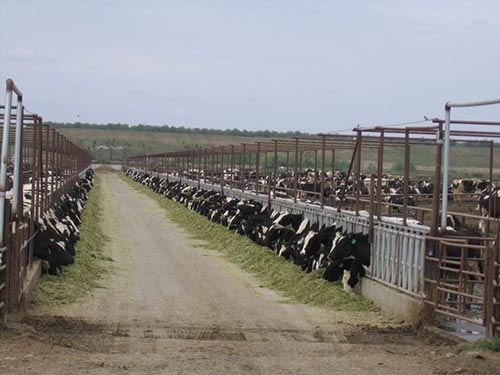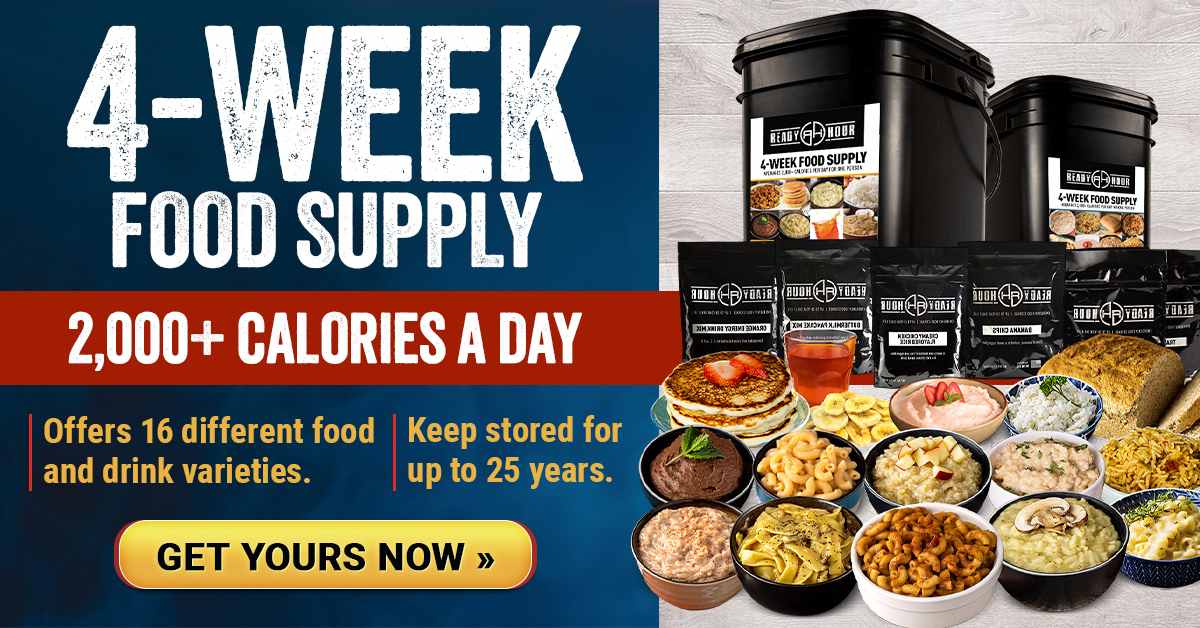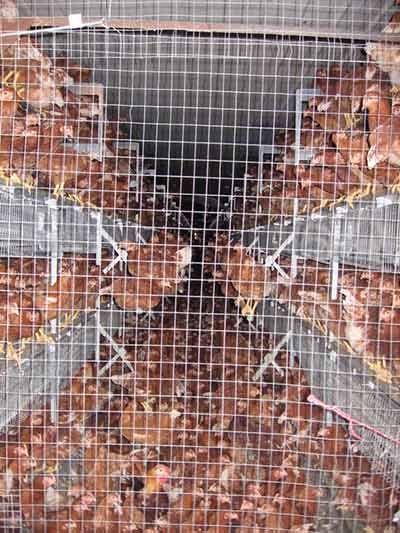STORY AT-A-GLANCE
- Draft regulation currently under consideration would legalize factory farm conditions for organic chickens
- While the proposed rule claims to protect and improve “animal welfare” in organic farming, all it will accomplish is the further destruction of independent organic farmers who do things right and therefore cannot compete with “organic” mega-corporations that can sell their foods at far lower prices because they cheat on the organic standards
- OrganicEye, an organic industry watchdog, warns the proposed rules undermine organic standards further by permanently codifying practices that violate the spirit of organics, and even the current letter of the law
- The proposed rule would allow organic poultry farmers to stack birds in multitiered aviaries stretching from floor to ceiling, providing as little as 1 square foot of space per animal. Outdoor space requirements are also limited to 1 to 2 square feet, depending on the size of the bird
- The draft rule allows egg-laying hens to be confined for the first 16 to 21 weeks of its life, and broiler chickens can be confined until just one or two weeks before their scheduled slaughter. The rule also allows half of the outdoor area to be covered in either concrete or gravel, which prevents the chickens from engaging in their natural instinctual behavior, which is already an organic requirement
At a time when organic farmers are going out of business and being gobbled up by corporate agribusinesses by the hundreds,1 draft regulation2,3,4 currently under consideration would legalize factory farm conditions for organic chickens, thereby pushing even more of the smaller organic farmers out.
While the proposed rule claims to protect and improve “animal welfare,” all it will accomplish is the further destruction of independent organic farmers who do things right and therefore cannot compete with “organic” mega-corporations that can sell their foods at far lower prices because they cheat on the organic standards.
There Are Two Kinds of Organic
According to U.S. Department of Agriculture’s National Agricultural Statistics Service, in 2019, nine organic-certified corporate-owned confined animal feeding operations (CAFOs) in Texas produced 1.5 times more “organic” milk than all 530 family-owned organic dairy farms in Wisconsin combined.5
As of 2021, there are 13 corporate dairies in Texas with organic certification, and they’re producing 2.8 times more “organic” milk than the remaining 407 organic family farms in Wisconsin.6 In those two years, 123 family farms went out of business in Wisconsin, as did hundreds more in other states.
When small organic farms go out of business, it’s not just that family that loses something. Consumers also lose. They lose access to authentic organic milk that meets their environmental expectations, and they’re deceived, because they think the higher price they pay provides economic justice and reward for farmers who are doing things right.
Meanwhile, most of the organic milk available comes from CAFOs that have anywhere from 10,000 to 20,000 cows, with a density of five to 10 cows per acre, that roam in desert conditions.7 The scene on these factory farms is as far from idyllic farm life as you can get.
Unlike on a family farm, these CAFO cows don’t graze on grass in pasture. Rather, pasture grass is cut and then fed to the cows, as shown below. When actual pasture size is considered, the effective stocking level can be as high as 20 cows per acre, whereas family farms typically provide 1 acre per cow.8
Industry Watchdog Issues Warning
According to the Organic Trade Association (OTA), the regulation is “the first significant movement on organic animal welfare in years.” The Humane Society Legislative Fund has also hailed the proposed rules as “a landmark federal regulation.”9
Mark Kastel, executive director of OrganicEye, an organic industry watchdog, vehemently disagrees, saying that rather than strengthening the organic label, the new regulations will undermine it further by permanently codifying practices that violate the spirit of organics, and even the current letter of the law.
“Organics was supposed to be the antidote to the ‘get big or get out’ draconian agribusiness domination of our food supply,” Kastel writes.10 Instead, organic companies have been acquired by conventional producers that slowly but surely have eroded organic standards through willful violations and lobbying.
As a result, 90% of “organic” eggs now come from gigantic confined animal feeding operations (CAFOs) owned by the largest suppliers of conventional eggs, and most certified organic chicken comes from companies that raise birds in near-total confinement and feed them imported grains that may or may not be truly organic, as organic grain fraud is now commonplace.
Legalizing Violations of the Organic Spirit
In a letter to members, Kastel writes:11
“For most of the last decade and a half, stakeholders in the organic industry have alleged that the largest egg companies in the United States have been operating mammoth livestock factories, with the USDA illegally granting organic certification.
In 2022, the agency released a new draft rule which they purport will bring these operations into compliance, assure a level playing field for competitors, and meet consumer expectations …
Other than family-scale farms producing certified organic eggs, the majority of production takes place on commercial operations — commonly with 20,000-30,000 birds per building — with some of the largest conventional egg marketers in the country operating certified organic houses with as many as 200,000 chickens per building and over a million birds on individual ‘farms’ …
The industry’s most vocal watchdog, OrganicEye, has vociferously criticized the proposed regulations as a giveaway to corporate agribusiness interests, codifying the continuing violations of the spirit and letter of the law by failing to assure that organically managed animals have legitimate access to the outdoors and are able to exhibit their natural instinctual behaviors, both requirements of the current statute and regulations.”
Proposed Standards Hardly Enshrine Animal Welfare
According to OrganicEye’s analysis, the proposed new organic rule would allow organic poultry farmers to stack birds in multitiered aviaries stretching from floor to ceiling, providing as little as 1 square foot of space per animal, and that’s including outdoor porches, which have limited access.
The following image was provided by OrganicEye as an example of what this “organic” CAFO setup looks like.
Outdoor requirements aren’t any better — just 1 to 2 square feet depending on the weight of the birds. For comparison, farmers who are part of the Organic Valley cooperative must provide at least 5 square feet per hen, and European organic regulations require 43 square feet per bird.12
The draft rule also allows egg-laying hens to be confined for the first 16 to 21 weeks of their life. After this much time spent in indoor confinement, many chickens are too frightened to ever venture outside. They’ve basically been trained not to roam. The situation is even worse for broiler chickens, which can be confined until just one or two weeks before their scheduled slaughter.
What’s more, the new rules would allow for half the outdoor area to be covered in either concrete or gravel. “How are the birds going to engage in their natural instinctual behavior — foraging, eating grass, scratching and pecking for bugs and worms — on concrete?” Kastel asks.
Proposed Rule Fulfills Corporate Lobbyists Wish-List
As noted by OrganicEye, these “anemic requirements” are “straight from the wish list of corporate lobbyists.”13 Indeed, U.S. Secretary of Agriculture Tom Vilsack himself is a former million-dollar-a-year agribusiness lobbyist who was named BIO Governor of the Year in 2001 by the Biotechnology Industry Organization (BIO) “for his support of the industry’s economic growth and agricultural biotechnology research.”14
So, Vilsack is hardly a champion for true organic farming, and the USDA’s failure to uphold the integrity of the organic standards under his stewardship15 highlights his corporate Big-Ag, biotech biases, as does his choice of members to the National Organic Standards Board (NOSB).
The NOSB is supposed to be a highly-diversified body of industry stakeholders, including organic farmers and consumer advocates, but contrary to that charter, at least 80% of current board members are now affiliated with the industry’s most powerful lobbying group, the OTA.16,17 According to Kastel:18
“The OTA has spent years, and invested untold corporate dues, in honing the persona that it is a tax-exempt nonprofit group working in the interest of the public when, in fact, it is a ruthless industry lobby group that has crossed swords with the nonprofit community on virtually every controversial issue before the NOSB.”
Several still independently-owned organic brands, such as Nature’s Path, Nutiva and Dr. Bronner’s, have resigned their memberships in the OTA in protest of its Big Ag bias.19
Under Vilsack, the NOSB was also stripped of its ability to set its own agenda. It’s supposed to work independently, but as small organic farmers have been bought up by large conventional ag conglomerates,20 the corporate dominance over the NOSB has also grown and organic standards have been watered down to benefit the largest of these corporate “organic” producers.
An Affront to Organic Consumers
OrganicEye describes the proposed rules as “an affront to consumers who are willing to pay a premium to support truly humane treatment of animals and to secure nutrient-dense and more flavorful food for their families.”21 Kastel adds:
“It’s Orwellian doublespeak, intentionally misleading the public, for the USDA to claim that these proposed rules are going to improve the status quo of factory farm production currently dominating organic livestock, or that they represent the expectations of consumers.”
OrganicEye board president Jim Gerritsen, a certified organic farmer in Maine, also stated:
“While USDA should be codifying the improved welfare of livestock, and increasing organic integrity, this misguided proposed rule sadly does neither. Rather, it enshrines the very practices which have allowed industrial factory farms to move in, take over, and push out hard-working organic family farms.”
A Call to Action
OrganicEye is now renewing its call to the USDA to enforce current organic regulations and is urging organic consumers and supporters to appeal to President Biden to intervene and stop this latest “giveaway to corporate lobbyists.”
Organic regulations already mandate outdoor access for all livestock, including pasture access for grass fed cows and other ruminants. Importantly, organically raised animals must, by law, have the opportunity to express their natural instinctual behaviors.
The problem is these rules are not being enforced, and the answer to nonenforcement is not new regulations that simply codify the violations and abuses that are already taking place on industrial-scale “organic farms.”
OrganicEye has created a proxy letter you can download here. Simply print it out, sign it, add any personal comments on the back, and mail it to OrganicEye. They will deliver the letters to Biden’s office. As noted in that letter:
“A new approach needs to be developed as an alternative to the tens of millions of dollars currently spent on annual inspections. The vast preponderance of documented fraud — what we assume is only the tip of the iceberg — is being discovered by OrganicEye and others outside of the certification/inspection process.
Resources should be focused on hiring experienced agriculturalists/forensic accountants for more comprehensive/periodic audits (punctuated with liberal unannounced inspections and testing).
The department needs to prioritize listening to the NGO community rather than corporate lobbyists who have been appointed to key leadership positions at the USDA and on the NOSB.”
- 1, 5, 6, 7, 8, 20 OrganicEye May 2, 2023
- 2 Federal Register Draft Regulation 7 CFR Part 205
- 3 Federal Register NOP Organic Livestock and Poultry Standards August 9, 2022
- 4 Center for Food Safety September 13, 2022
- 9 Agriculture.com August 8, 2022
- 10 Dropbox Letter from Mark Kastel 2
- 11, 12, 21 Dropbox Letter from Mark Kastel
- 13 OrganicEye Proxy Letter to President Biden
- 14 Bio.org September 20, 2001
- 15 Real Organic Project
- 16, 18, 19 OrganicEye April 18, 2023
- 17 OrganicEye April 2023 NOSB Meeting
Article cross-posted from Dr. Mercola’s site.








